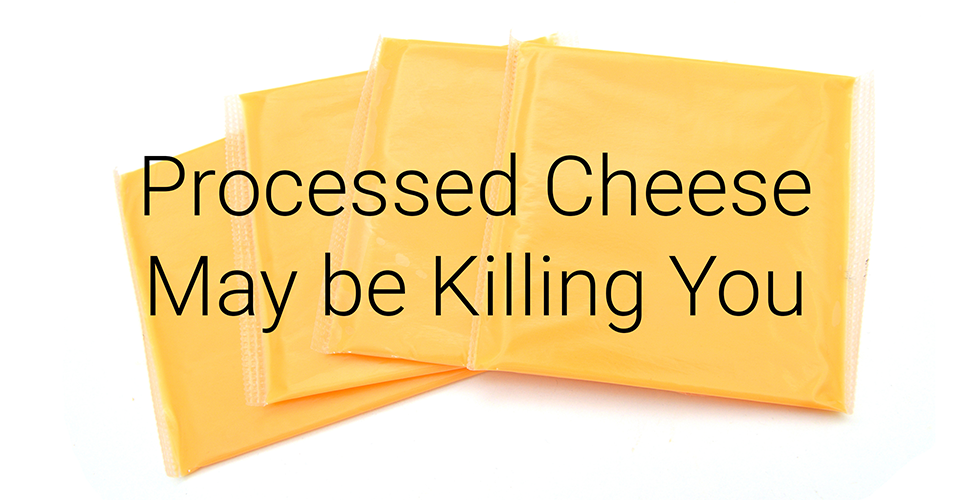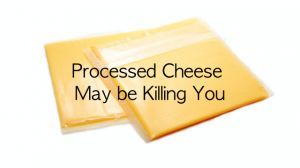
Spreadable cheese, sliced cheese, string cheese, individually wrapped cheese, and spray cheese. These are just some of the weird and wonderful modern prepared cheese foods we have access to these days.
If you look at the labels of various cheese products in the grocery store, you will likely see claims like “good source of calcium,” “made with real milk,” or “kids eat right.” You might think that consuming cheese products ticks off your nutritional boxes by providing the requisite servings of dairy for the day.
However, if you look a little deeper, you might find that processed cheese is simply an industrially produced, recently invented digestible product, and not a real food at all. In fact, it is credited to a Swiss inventor from the early twentieth century.
What is processed cheese made of?
The first hint of concern is when you turn over the package and see a list of ingredients a mile long. This is not the fresh farm cheese with only three or four ingredients that your ancestors ate just a few generations ago. This stuff contains dairy by-products, emulsifiers, saturated vegetable oils, excess sodium, food coloring agents, preservatives and sugar.
Many manufacturers claim that their product is made from or with real cheese, which might be true, but the cheese base is considerably transformed by the time the processed product is complete. Processed cheese is essentially a cleverly engineered and mass produced product that is designed to taste good and perform well in the mass food market at a very low cost.
Some processed cheese is so artificial that it cannot be legally labeled as “cheese,” so it is referred to as “cheese food,” “cheese spread” or “cheese product.”
Here are some FDA labeling guidelines so that you can gain insight into what you might be eating:
· Pasteurized process cheese — contains 100% cheese
· Pasteurized process cheese food — contains at least 51% cheese
· Pasteurized process cheese product — contains less than 51% cheese
Dairy by-products: Don’t be tricked into thinking this is akin to wholesome real milk. We are taking about all forms of modified milk ingredients, such as whey, protein concentrates, milk fat, and dehydrated dairy powder. This can include milk protein concentrate, which is generally a cheaply imported product. The use of milk protein concentrate stipulates the labeling of the food as a “product,” i.e., it can no longer be legally labeled as cheese.
Emulsifiers: These are added to keep the processed cheese at an even texture throughout the product and also when it is melted. Conversely, natural cheese tends to separate into lumps of protein and liquid fat when it is heated. Examples of common emulsifiers include sodium phosphate, potassium phosphate, tartrate or citrate.
Sometimes starches and gums are also used to improve the texture. Processed cheese will melt, spread and stretch evenly without changing texture or congealing. Doesn’t this remind you of something? That’s right, plastic! It should go without saying that these substances pose significant health risks.
Vegetable oils: A variety of nasty, industrially produced oils, such as soy, sunflower, canola and corn oil, are used in processed cheese products to improve flavor and texture. They also serve as cheap fillers to bulk up the product so that less real cheese needs to be used.
Sodium and sugar: Processed cheese normally contains at least twice as much sodium as is used in the making of natural cheese. This is because food manufacturers have become wise to the particular combinations that trigger our taste buds and brains most effectively. Along with the mouthfeel from the emulsifiers and the fats from the vegetable oils, processed cheese is a carefully concocted consumer pleaser.
In fact, until recently, there was little research available on processed cheese because many manufacturers protected their individual products under patents. Since processed cheeses were introduced in the United States post-Second World War, the patents have now expired and we are able to gain insight into these unfortunately popular consumer products.
Artificial colors: Along with the other carefully composed properties of processed cheese, the color is also made “just right” to tempt the eye of purchasers. Some examples of coloring agents include apocarotenal, yellow dye and yellow tartrazine.
Preservatives: One of the major appealing points of processed cheese for food manufacturers is its long shelf life. This is thanks to a range of additives, which preserve the product for longer storage and therefore less chance of lost revenue. Some common preservatives include sorbic acid and sodium citrate.
Some processed cheese is so heavy on these additives that it doesn’t even need to be refrigerated. Try leaving a slice of plastic wrapped cheese on your windowsill. After a few weeks it will turn brown and begin to dry up, but it probably won’t grow mold. That’s because microorganisms know better than to eat that garbage!
All these ingredients are mixed together and heated with an emulsifier, then poured into a mold and left to cool. This process can be highly mechanized to keep cost and human involvement low.
Health effects of processed cheese ingredients
Many of the ingredients used in processed cheeses come with potential health risks.
Vegetable oils: These oils are highly refined and oxidized, rendering them toxic and inflammatory. Vegetable oils of any type are best avoided, and particularly those that have been hydrogenated. They are full of the fats that clog arteries and promote obesity.
Sodium phosphate: This ingredient is used as an emulsifier in processed cheese products, but it is also used in pharmaceutical medications and comes with a warning for possible kidney damage.
Potassium phosphate: This is used as an emulsifier and preservative in processed cheeses, but also as a medication for kidney stones and to make urine more acidic. It may trigger allergic reactions.
Tartrates: May cause diarrhea.
Coloring agents: Yellow 6 and yellow tartrazine are banned by the European Union because they have been shown to promote tumor growth in animal studies.
Trisodium phosphate: This emulsifier is the ingredient that makes sprayable cheese so smooth. The bad news is that trisodium phosphate is also used in cleaners and stain removers.
Isolated and artificial vitamins: You may think it’s good that your cheese product has been fortified with a selection of vitamins, but these isolated forms cannot be absorbed properly by the body, and may even be toxic.
Sodium and sugar: Processed foods contain pure sodium, which is a purified form of salt. Natural salts, on the other hand, contain other trace minerals, which make them more easily absorbed by the body. Sodium on its own can be dangerous in excess. Sugar is ubiquitous in our culture and should be reduced as aggressively as possible. Sugar is certainly never an ingredient in real natural cheeses.
Overall, processed cheese products are an unholy mess of chemicals and additives, one worse than the next. When so many things must be added to make it taste good, is it really worth eating?
What is real cheese made of?
 On the other hand, real cheese is much simpler and more wholesome. Real cheese is made by heating milk and adding in natural enzymes and bacterial cultures. Then the curds (fatty lumps) are separated from the whey (protein liquid), after which the curds are salted and shaped into a wheel or block to age.
On the other hand, real cheese is much simpler and more wholesome. Real cheese is made by heating milk and adding in natural enzymes and bacterial cultures. Then the curds (fatty lumps) are separated from the whey (protein liquid), after which the curds are salted and shaped into a wheel or block to age.
Natural cheese is often aged for an extended period of time, anywhere from a few days to many years. This makes it more expensive and less convenient for food manufacturers and consumers. However, buying real cheese supports a time-tested, earth-friendly economic system based on farming.
Since there is little modification involved in the production of natural cheese, it offers up generous amounts of nutrients that the body can readily absorb. This is because they are in a whole-food state, rather than being isolated and added in. Some of the highlights include calcium, phosphorus, zinc, vitamin A, vitamin D and vitamin K2. Rinds formed by the cheese culture may also be rich in B vitamins.
How to choose the healthiest cheese
Look for raw milk cheese with full fat. It’s worth seeking out pricier cheese to get as close as possible to cheese the way it’s intended to be. Not only do real cheeses provide unadulterated fats and proteins, but they can also be a source of healthy probiotic bacteria for good gut health.
If you can source cheese that has been made from the milk of grass-fed cows, this is the best option. Cows thrive when they are fed grass, and their milk contains higher levels of healthy omega-3 fatty acids. Grains, on the other hand, cause inflammation, and subsequently the cows produce lower quality milk.
Some smart choices include any real high quality varieties, including Swiss cheese, Parmesan cheese, Edam, feta, goat’s cheese, ricotta, mozzarella, and Brie, etc. The place to find good cheese is at your local farmer’s market or specialty food store. Many large supermarkets also carry higher quality cheeses in the delicatessen area, as opposed to the main dairy case.
Call to Action:
Stop feeding yourself and your family an industrial food product and reach for real, wholesome cheese instead. Your body will surely thank you for it! Check out these tasty ideas and inspiration to kickstart your real food journey today.
—Liivi Hess
Liivi is an Integrative Nutrition Health Coach and is training to become a doula. She inspires women to find peace and personal power by taking control of health and fertility naturally. Liivi‘s passion is ancestral nutrition and primal lifestyle design. She and her partner Will live between Toronto, Canada and Queenstown, New Zealand.
Sources:
http://www.mirror.co.uk/news/weird-news/whats-processed-cheese-slices-shock-5022840
http://www.eatingwell.com/nutrition_health/nutrition_news_information/is_it_still_cheese
https://msu.edu/~mdr/vol14no2/ustunol.html
http://www.onegreenplanet.org/news/why-processed-cheese-is-not-a-healthy-option-for-kids
http://www.dailymail.co.uk/health/article-193792/The-good-cheese-guide.html
http://www.ncbi.nlm.nih.gov/pubmed/19179058
http://www.nytimes.com/2011/02/05/business/05cheese.html?pagewanted=all&_r=3&
http://www.theguardian.com/lifeandstyle/wordofmouth/2012/nov/29/how-choose-healthier-cheese

